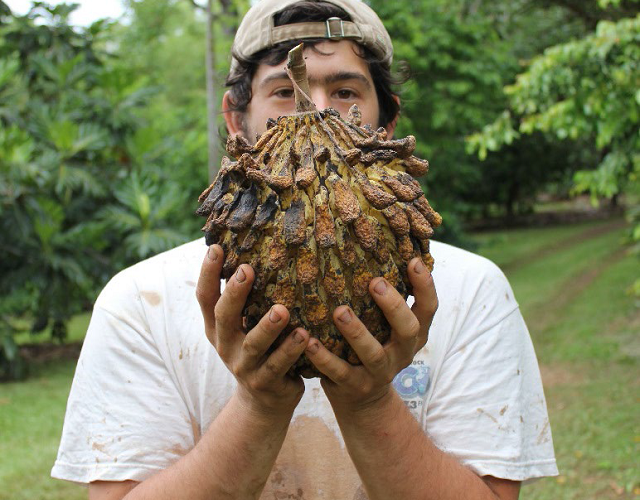A fruit is tied to, (not exclusively), flowering plants or angiosperms. It is known as a seed bearing
structure formed from the ovary of the plant after flowering. It is a fleshy and sometimes flavorful or
sweet outer layer (pericarp) of a seed. Hawai‘i nei is located in the humid sub-tropics, which is essentially a fruit paradise, the climate provides a wonderful habitat for trees to thrive and allows humans the opportunity to enjoy an abundance of fruit diversity. Most food flavorings that we know today have a fruity ancestor, from brilliant reds and oranges to dark greens and black, fruit colors and flavors can seldom be rivaled.
In nature, fruits attract animals whose foraging activities disperse the seed(s) within. A well-known
example of this is a mango. A mango tree produces a large seed covered with a delicious outer layer. An
animal eats the fruit removes the outer layer, and sets the seed (often times in a cool shady spot away
from the mother tree) ready to sprout and grow!
Humans disperse fruit seeds on a massive scale. With human action, fruits and seeds are moved across continents and oceans. They can be cultivated far and wide outside of the fruit’s natural or native habitat. The story of John Chapman, more well-known as “Johnny Appleseed”, is a great example of animals spreading seeds and fruit far beyond the natural range of the tree. Unfortunately, native habitats may be ill-prepared for potential invasions. In our Hawaiian home, we have seen that guava, coffee, and others can hinder the growth of our native species that leads to environmental effects like erosion and the smothering of our reefs, and habitat loss for native insect species.
It may come as a surprise that in old Hawai‘i large, fleshy, delicious fruits were nearly non-existent.
With the exception of a few (somewhat bland) fruits such as Haha (Cyanea sp.), Mamaki (Pipturus sp.), ‘Akala (Rubus sp.), and ohelo (Vaccinium sp.). Kanaka maoli relied on few truly native fruit. Polynesian introductions included only a few staple fruits such as ‘ulu (breadfruit), niu (coconut), and ‘ohia’ai (mountain apple). The rest of the commonly-known fruits around Hawai‘i are very recent, post-contact introductions.
With heavy reliance on Hawai‘i as a trade route and key military location over the last two centuries, many new fruit introductions have been made. The tropical fruits that we are accustomed to now, share similar stories of arrival. Without the far reach of humans, these iconic fruits would not be found in the Hawaiian islands: mango, litchi, avocado, macadamia, soursop, jackfruit, citrus, papaya, tropical almond, tamarind, Surinam cherry, figs, pomegranates, java plum, wi, and rose apple all of which have made Hawai‘i their permanent residence. A few of these foreign fruit species have come to the islands and created entire industries around them (Mauna Loa Macadamia, Kona coffee, pineapple, the Hilo lychee).
Litchi chinensis (Lychee, litchi, lihzi) was imported from China in 1875 by a Honolulu merchant Mr. Ching-Chock. The tree was planted on the property of Mr. Chun Afong on the corner of Nu’uanu and School Street. Happily growing in this location it was known locally as the “Afong tree”. Some years later it was thought to be the Chinese variety of lychee called ‘kwai mei’ but later identified as ‘Tai tso’. Many fruit trees come to the humid subtropics and thrive, others that are environmentally sensitive, such as lychee, have been improved with the hard work of horticulturist. Since the coming of the first lychee tree, we now have many “low chill” varieties which are much more suited for our local climate. Some of these improved Hawaiian varieties are ‘Groff’ and ‘Kaimana’ which are very sought after for their tolerance to no chill as well as harvest time. There is a similar story with most of the other fruit mentioned above. It is a true wonder that we have the ability to grow such abundance year around here in Hawai‘i.
Everyone can agree that this lychee season and most other fruit seasons can be very abundant and even overwhelming. What is one to do with such an overabundance of fruit? Everyone loves the neighbor that gives us bags of fruit, but often times we are stuck not using the fruit that we have. There are many ways to utilize all of the fruit that is around. Depending on the fruit that you have, you may want to try freezing, dehydrating, making a puree, selling, or just going out of your way to give friends and family that perfect fruit!



